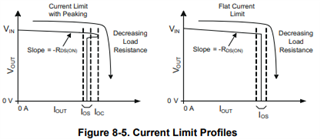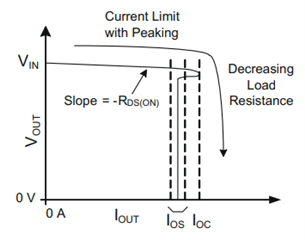Tool/software:
Hi team,
I'd like to know if this change in text is a typo or not.
If not, could you explain what the differences are?
p.21 8.3.7 Over current
"Current Limit with Peaking" to "Flat Current Limit"
BR,
Kengo.
This thread has been locked.
If you have a related question, please click the "Ask a related question" button in the top right corner. The newly created question will be automatically linked to this question.
Tool/software:
Hi team,
I'd like to know if this change in text is a typo or not.
If not, could you explain what the differences are?
p.21 8.3.7 Over current
"Current Limit with Peaking" to "Flat Current Limit"
BR,
Kengo.
Hi Kengo,
Figure 8-5 visually explains the difference between the two. See image below.

The Overcurrent Condition behavior of the TPS2051B falls under the "Flat Current Limit". For devices that fall under the "Flat Current Limit" group, after the short-circuit output current threshold (Ios) is reached, the device immediately switches into constant-current mode at the Ios level.
For the devices that fall under the "Current Limit with Peaking" group, after the current-limit circuit has tripped (reached the overcurrent trip threshold (Ioc), the device switches into constant current mode and current is limited at the short-circuit output current threshold (Ios).
Hope this helps,
Seong
Hi Seong,
Thank you for your reply.
Are you saying that it was originally a flat current limit instead of a peak current limit?
In other words, nothing has changed on the device, only the datasheet has changed, right?
BR,
Kengo.
Hi Kengo,
There was a change in the device's design, so that the overcurrent behavior was improved from "Current Limit with Peaking" to "Flat Current Limit" (and process technology to LBC9/300mm wafers, yielding increased supply).
BR,
Seong
Hi Kengo,
The following are the changes in other device characteristics:
So the changes are not significant and are marginal.
"Current Limit with Peaking" has an I_oc, or overcurrent trip threshold, which was nominal 1.5A and max 1.9A. As Figure 8-5 shows, the output current had to reach this threshold level to detect an overcurrent condition before switching into a constant-current mode and limiting the current within the I_os range. See "Current Limit with Peaking" plot below.

With "Flat Current Limit", as Figure 8-5 shows, the device immediately switches into a constant-current mode when it detects the output current to be within the I_os range and keeps it in this range. See the "Flat Current Limit" plot below.

For more information on the TPS2051B's Overcurrent feature, see Sections 8.3.7 and 8.3.7.2 in the datasheet here.
BR,
Seong